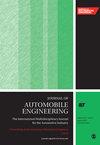Enhancing perception of vehicle motion by objective positioning of the longitudinal axis of rotation in driving simulators
IF 1.5
4区 工程技术
Q3 ENGINEERING, MECHANICAL
Proceedings of the Institution of Mechanical Engineers Part D-Journal of Automobile Engineering
Pub Date : 2024-08-27
DOI:10.1177/09544070241266444
引用次数: 0
Abstract
The automotive industry is heading towards a more objective approach to vehicle testing, but subjective evaluation is still an important part of the development process. Subjective evaluation in physical testing has environmental implications and is dependent on ambient conditions. A more repeatable, faster, safer and more cost-effective tool for subjective evaluation is to use moving base driving simulators. The motion cueing algorithms (MCA) maps the movement of the vehicle into the limited space of the simulator. The choice of reference point, that is, where on the vehicle to sample the motion to feed to the MCA and the alignment of the axis of rotation of the simulator cabin is still an open topic. This paper investigates the choice of reference point and corresponding simulator longitudinal axis of rotation in roll using two methods. The first method uses a linearised model of the combined system of vehicle, simulator and vestibular models. The second method, to position the cabin longitudinal axis of rotation, is based on offline optimisation. The linear model can capture important characteristics of the specific forces and rotations that are fed to the driver through the motion cueing algorithms and offers a method to objectively analyse and potentially tune the motion cueing. The analysis is further complemented with a subjective evaluation of corresponding settings. The results from the linear model, the offline optimisation and the subjective evaluation shows that a reference point at the driver’s head has a clear advantage over the full frequency range compared to a reference point in the chassis roll axis and that the positioning of the cabin longitudinal axis of rotation has a significant effect on the perceived vehicle characteristics.通过客观定位驾驶模拟器的纵向旋转轴来增强对车辆运动的感知
汽车行业正朝着更客观的汽车测试方法发展,但主观评价仍是开发过程的重要组成部分。物理测试中的主观评价会对环境产生影响,并取决于环境条件。一种可重复性更高、更快、更安全和更具成本效益的主观评价工具是使用移动底座驾驶模拟器。运动提示算法(MCA)将车辆的运动映射到模拟器的有限空间内。参考点的选择,即在车辆的哪个位置对运动进行采样以输入 MCA,以及模拟器机舱旋转轴的对齐方式,仍是一个未决课题。本文采用两种方法对参考点的选择和相应的模拟器纵向旋转轴的滚动进行了研究。第一种方法使用车辆、模拟器和前庭模型组合系统的线性化模型。第二种方法是基于离线优化来定位座舱纵向旋转轴。线性模型可以捕捉到通过运动诱导算法反馈给驾驶员的特定力和旋转的重要特征,并提供了一种客观分析和潜在调整运动诱导的方法。该分析还辅以对相应设置的主观评估。线性模型、离线优化和主观评估的结果表明,与位于底盘滚动轴的参考点相比,位于驾驶员头部的参考点在全频率范围内具有明显优势,而且座舱纵向旋转轴的定位对感知的车辆特性具有显著影响。
本文章由计算机程序翻译,如有差异,请以英文原文为准。
求助全文
约1分钟内获得全文
求助全文
来源期刊

CiteScore
4.40
自引率
17.60%
发文量
263
审稿时长
3.5 months
期刊介绍:
The Journal of Automobile Engineering is an established, high quality multi-disciplinary journal which publishes the very best peer-reviewed science and engineering in the field.
 求助内容:
求助内容: 应助结果提醒方式:
应助结果提醒方式:


